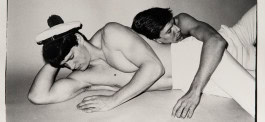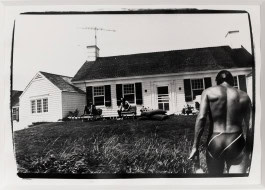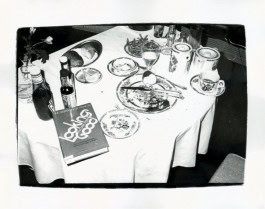
Is voyeurism and investigation what essentially defines Andy Warhol’s longing for closeness and belonging? Belonging – longing to be.
Curator and Exhibitions Manager at Fotografiska Berlin, Thomas Schäfer, together with co-curator and loaner James R. Hedges IV, has caught exactly that nuance from the repertoire of photographs by the great artist. Hollywood’s glamorous elite society posed an irresistible allure to Andy Warhol. He wanted to penetrate, investigate and belong to their circle, and had just the right tool for that: the camera device. That, and his groundbreaking artistic and photographic methods along with the psychological astuteness to invoke his subjects’ vulnerability, allowed him to manufacture his own celebrity persona. It was his golden ticket to Hollywood, putting a stamp on his longing for belonging.
But what did curator Thomas Schäfer see behind his enigma?
He certainly didn’t focus on the trivial: the Andy Warhol we all know; the famous banana album cover for The Velvet Underground, or his commercial illustrations. On the contrary, Thomas used his own curatorial and archival skills as a tool, similar to the camera, to apply Andy’s voyeurism and investigation method. The result is a raw and genuine peek into Andy Warhol’s behind-the-camera desires and personal cosmos.
“I had the opportunity to really dive in the archives of wonderful loaners such as James R. Hedges IV, and they offered me a glimpse into this deeper spectrum of the works. I found this very tender print of uncleared tabletops in an empty hotel room, then the spark ignited in my mind that I want to have the insight of how Andy understood the world. I also read between the lines that he had a longing to belong to certain communities and to the celebrities. And since this anchor is more personal, I decided to title the exhibition ‘After the Party’,” shared curator Thomas Schäfer.

ㅤ
As if to throw us into that deep underwater cosmos of the artist, Thomas opens the exhibition with Andy Warhol’s iconic self-portraits. Looking into his eyes, we notice a sense of sadness, mirroring his longing for this elite world and the deep agony of unfulfilled desires. The self-portraits “start early in his career, when you see him with this perfect facade and artistic avatar he created to live in this world back then in ‘70s and ‘80s New York, until the very last two self-portraits which were taken literally a few months before his passing away. That way you can get to know him and study him”.
To continue the line of investigation, we move onto his polaroid celebrity portraits, spanning from Dolly Parton to Diane Von Furstenberg to Tina Turner. His photographic method allowed him to get intimate with his guests in a non-sexual way.
“Andy was an observer, repeatedly observing communities and trying to unpeel the layers of the celebrities which he invited to the studio for the celebrity portraits. They spent hours, maybe even the full day. He offered them food, and then they drank together and they chatted, and he took hundreds of polaroids. Then, he found and captured this moment which is very pure and very honest, and that’s what I love about this work. It tells me about him through the way he uses photography in the exhibition,” commented Thomas.
Andy was certainly bold in his photographic approach, reflecting his deep desire to be accepted and as a means to maintain his artificial persona. He would often take celebrities into a dark red light neighborhood, “not to scare them, but to really ground them”. Then, he would put them in a photobooth, shut the curtain, and let the machine photograph them. These photobooth strips are on display in the exhibition, along with close-up videos of celebrities that allow you to really stare into their eyes and wonder what notes the artist was taking during these sessions.
As the groundbreaker Andy was, he developed a new way of portraiture, while reiterating common elements from his work. These repetitional images served as a safety container, allowing him to fall back on his trusted repetition method and ground himself. It was sort of a way to tame his stardom obsession, and we can see it beautifully elucidated in the exhibition through different points of his life, illustrating the division between the real, vulnerable Andy and the celebrity Andy.
Then there were the parties. Thomas adeptly managed to follow the transition between the height of the party night, with celebrities gathered around abundant tables, smoking cigarettes and chatting, to the after the party scene, when everyone had left but Andy.
Take a step back from the intricately arranged party photographs on the wall, look around, and you will feel like you’ve transcended into ‘70s/’80s New York. There is the dark room with the lit photographs, resembling ‘80s Hollywood glamor, the dim atmosphere, and songs such as “You Showed Me” by The Turtles, oh, and there is Andy Warhol peeking from one of the photographs on the wall arrangement. It is certain that Thomas has fine-tuned every single detail of the exhibition, from the visual elements to the audio immersion. It’s like experiencing an AR exhibition but without the technology; only through Warhol’s art and Thomas’ curatorial astuteness.
Move to the right and step into the parlor of domestic photography. Strategically placed, this part of the exhibition displays empty hotel rooms, chairs and uncleared tabletops. For Andy, they were a very personal space, because he lived there.
“Then, the after the party theme developed. We have works from the Montauk series. Montauk was his estate north of New York where he escaped from the buzzing New York city life. The interesting story about Montauk is that he acquired it with his partner, and then rented it out to celebrities. He would then invite himself as a guest and start taking pictures. There is a picture with Mick Jagger serving tea to him. I think there is a humorous side to it, so it’s very honest, very transparent, and also capitalistic in some way. Because he was a capitalist artist, he wanted to be successful and earn money,” added Thomas.



Another lure to the more personal and intimate part of Andy’s life are the flower photographs. Andy does just as good justice to capturing the soft, feminine side as he does to portraying sexualized masculinity. Yes, the tender embraces of queer men certainly demonstrate a notch of femininity, but the flower photographs represent an even more nuanced side of that. Thomas has intentionally positioned them in the domestic section. Not to diminish the role of the woman, but to showcase her powerful emanation of the feeling of safety, belonging, beauty and orderliness, represented by the home.
In the party scene, this longing for belonging is seen in a completely different light: the galore and climax of the party, followed by the sadness and emptiness once everyone leaves – the after the party scene. Andy Warhol was in a constant search for romantic love, someone to fill his home.
As an ode to the feminine, he captures photographs of flowers through the lens of intimacy. A symbol of female genitals, they complement the literal representation of male genitals in his nude photographs. Feminine and masculine merge together. And while they find peace and synergy in his artistic work, do they do so in his personal life?
Perhaps the exaggeration of male nudity and pornograhic imagery is a way for him to come to terms with his sexuality. It is also a pioneering act in demonstrating open sexuality. In this coming of age scenario, Andy was looking for the fine line between art and pornography.
“It was quite challenging to do it at this point of time, to really define, or maybe to really challenge the border between pornography and fine art, and to have these tender topographies of penis, buttocks, and even sexual gestures. It is pornogrpahy, but the way and when he did it and the conceptual idea behind it, of course, is an artistic element and a language he uses,” explained Thomas.
We then finish the tour, there, amidst the nude photos and the most intimate side of Andy Warhol. The last thing we watch is a short movie titled “Blow Job”. It is far from pornography; rather, a tender, vulnerable and creating a sense of closeness and belonging rendition of a beautiful intimate act. That’s the journey of the iconic artist and photographer, seen through his personal lens. Andy Warhol: Unpeeled.
Related Articles: